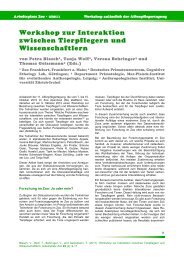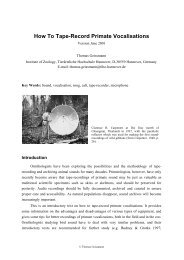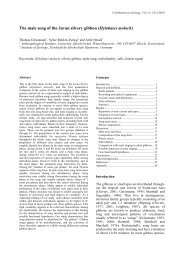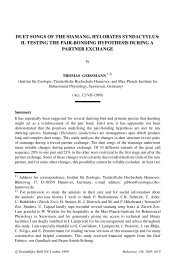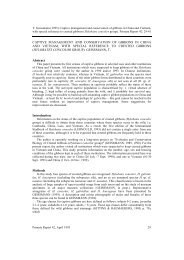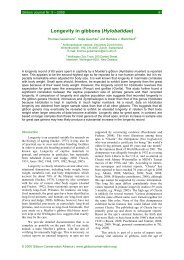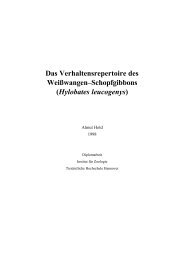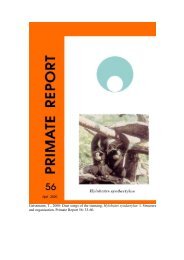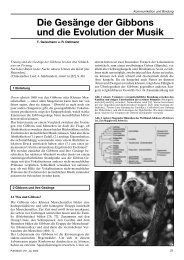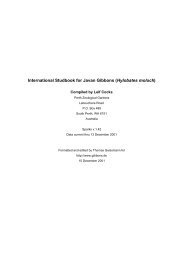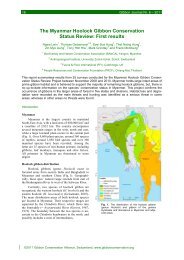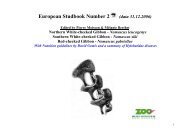The Conservation Status of Gibbons in Vietnam - Gibbon Research ...
The Conservation Status of Gibbons in Vietnam - Gibbon Research ...
The Conservation Status of Gibbons in Vietnam - Gibbon Research ...
Create successful ePaper yourself
Turn your PDF publications into a flip-book with our unique Google optimized e-Paper software.
<strong>The</strong> <strong>Conservation</strong> <strong>Status</strong> <strong>of</strong> <strong><strong>Gibbon</strong>s</strong> <strong>in</strong> <strong>Vietnam</strong>9.4 Characteristics <strong>of</strong> the Crested <strong><strong>Gibbon</strong>s</strong> <strong>in</strong> <strong>Vietnam</strong>9.4.1 Eastern Black <strong>Gibbon</strong> Nomascus nasutusAdult males and juveniles are almost completely black with a brownish t<strong>in</strong>ge on the chest andfrontal areas, and an only moderately developed crown crest. Adult females are pale yellow,yellow, orange or beige brown, exhibit a broad whitish face r<strong>in</strong>g, and have a black cap that varies<strong>in</strong> size. Chest and sometimes the belly are adorned with a patch <strong>of</strong> vary<strong>in</strong>g size consist<strong>in</strong>g <strong>of</strong> grey,brown or blackish hairs. <strong>The</strong> black crown is connected to the black facial area. It is narrow <strong>in</strong> thefrontal area, becomes wide at the top <strong>of</strong> the head, and extends past the nape and across theshoulders where it then tapers toward the centre <strong>of</strong> the sp<strong>in</strong>e above or past the scapula.Description after Geissmann et al. (2000), Groves (2001), Mootnick (2006) and Mootnick and FanPengfei (2011).Fully developed male vocalizations consist <strong>of</strong> only two <strong>of</strong> the three note types described for malecrested gibbons (Geissmann 1993, 1995; Geissmann et al. 2000): staccato phrases and multimodulatedphrases; boom notes are absent (Figure 13). Staccato notes are short and consist <strong>of</strong> arapid up-down sweep <strong>in</strong> frequency. <strong>The</strong> multi-modulated phrase is much more simple than <strong>in</strong>other crested gibbons. <strong>The</strong> first note usually differs from the other notes <strong>of</strong> the phrase and beg<strong>in</strong>swith a slow and moderate <strong>in</strong>crease <strong>in</strong> frequency, followed by a more pronounced and long downsweep<strong>in</strong> frequency. <strong>The</strong> follow<strong>in</strong>g notes exhibit a different design and consist ma<strong>in</strong>ly <strong>of</strong><strong>in</strong>creas<strong>in</strong>g frequency. <strong>The</strong> up-sweep is slow and moderate <strong>in</strong> the first part <strong>of</strong> the note, and shortand pronounced <strong>in</strong> the second part. <strong>The</strong>se notes sound like “cao-vit” or “cao-vat”, which gave thegibbon its local name <strong>in</strong> Bac Kan Prov<strong>in</strong>ce (Geissmann, unpublished <strong>in</strong>formation). Adult malesproduce a special multi-modulated phrase, the “coda”, dur<strong>in</strong>g or immediately after the climax <strong>of</strong>the female great call. <strong>The</strong> coda phrase may <strong>in</strong>clude notes consist<strong>in</strong>g <strong>of</strong> a frequency down-upsweep, which appear u-shaped <strong>in</strong> sonograms. Complete great call phrases <strong>of</strong> adult femalesconsist <strong>of</strong> a series <strong>of</strong> 8-12 notes. All great call notes except the first 2-3 consist <strong>of</strong> very rapid vibratosounds. <strong>The</strong>se notes somewhat resemble the twitter-like vocalizations which follow at the end <strong>of</strong>the great call <strong>in</strong> other crested gibbons (Geissmann 1989, 1997; Geissmann et al. 2000; Van NgocTh<strong>in</strong>h et al. 2010d; Van Ngoc Th<strong>in</strong>h et al. 2011). Great calls <strong>of</strong> N. nasutus (and N. ha<strong>in</strong>anus) do notreach the high frequency levels <strong>of</strong> great calls <strong>of</strong> other crested gibbons: all fundamentalfrequencies are below 2.8 kHz, whereas <strong>in</strong> other crested gibbons, great call frequencies typicallygo up to above 3 kHz (Geissmann et al. 2000).Figure 13. Sonogram show<strong>in</strong>g call sequence <strong>of</strong> Nomascus nasutusSeveral male phrases cont<strong>in</strong>ued dur<strong>in</strong>g great call and directly followed by male coda near the end <strong>of</strong> the great call.Adapted from Van Ngoc Th<strong>in</strong>h et al. (2011).103



